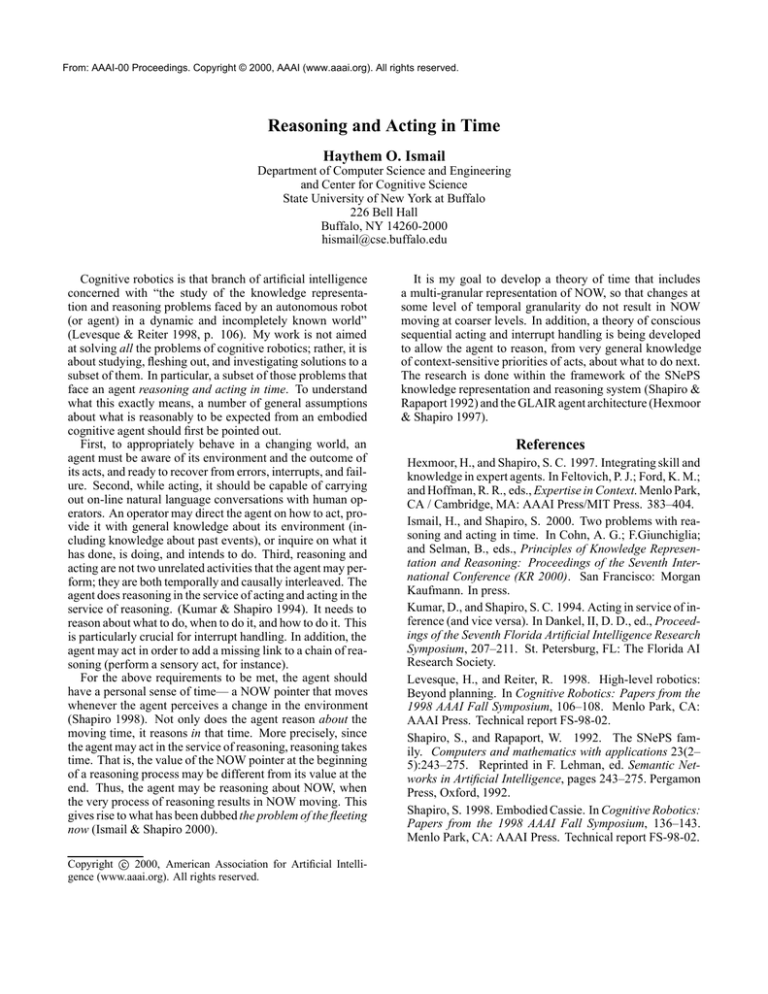
From: AAAI-00 Proceedings. Copyright © 2000, AAAI (www.aaai.org). All rights reserved.
Reasoning and Acting in Time
Haythem O. Ismail
Department of Computer Science and Engineering
and Center for Cognitive Science
State University of New York at Buffalo
226 Bell Hall
Buffalo, NY 14260-2000
hismail@cse.buffalo.edu
Cognitive robotics is that branch of artificial intelligence
concerned with “the study of the knowledge representation and reasoning problems faced by an autonomous robot
(or agent) in a dynamic and incompletely known world”
(Levesque & Reiter 1998, p. 106). My work is not aimed
at solving all the problems of cognitive robotics; rather, it is
about studying, fleshing out, and investigating solutions to a
subset of them. In particular, a subset of those problems that
face an agent reasoning and acting in time. To understand
what this exactly means, a number of general assumptions
about what is reasonably to be expected from an embodied
cognitive agent should first be pointed out.
First, to appropriately behave in a changing world, an
agent must be aware of its environment and the outcome of
its acts, and ready to recover from errors, interrupts, and failure. Second, while acting, it should be capable of carrying
out on-line natural language conversations with human operators. An operator may direct the agent on how to act, provide it with general knowledge about its environment (including knowledge about past events), or inquire on what it
has done, is doing, and intends to do. Third, reasoning and
acting are not two unrelated activities that the agent may perform; they are both temporally and causally interleaved. The
agent does reasoning in the service of acting and acting in the
service of reasoning. (Kumar & Shapiro 1994). It needs to
reason about what to do, when to do it, and how to do it. This
is particularly crucial for interrupt handling. In addition, the
agent may act in order to add a missing link to a chain of reasoning (perform a sensory act, for instance).
For the above requirements to be met, the agent should
have a personal sense of time— a NOW pointer that moves
whenever the agent perceives a change in the environment
(Shapiro 1998). Not only does the agent reason about the
moving time, it reasons in that time. More precisely, since
the agent may act in the service of reasoning, reasoning takes
time. That is, the value of the NOW pointer at the beginning
of a reasoning process may be different from its value at the
end. Thus, the agent may be reasoning about NOW, when
the very process of reasoning results in NOW moving. This
gives rise to what has been dubbed the problem of the fleeting
now (Ismail & Shapiro 2000).
Copyright c 2000, American Association for Artificial Intelligence (www.aaai.org). All rights reserved.
It is my goal to develop a theory of time that includes
a multi-granular representation of NOW, so that changes at
some level of temporal granularity do not result in NOW
moving at coarser levels. In addition, a theory of conscious
sequential acting and interrupt handling is being developed
to allow the agent to reason, from very general knowledge
of context-sensitive priorities of acts, about what to do next.
The research is done within the framework of the SNePS
knowledge representation and reasoning system (Shapiro &
Rapaport 1992) and the GLAIR agent architecture (Hexmoor
& Shapiro 1997).
References
Hexmoor, H., and Shapiro, S. C. 1997. Integrating skill and
knowledge in expert agents. In Feltovich, P. J.; Ford, K. M.;
and Hoffman, R. R., eds., Expertise in Context. Menlo Park,
CA / Cambridge, MA: AAAI Press/MIT Press. 383–404.
Ismail, H., and Shapiro, S. 2000. Two problems with reasoning and acting in time. In Cohn, A. G.; F.Giunchiglia;
and Selman, B., eds., Principles of Knowledge Representation and Reasoning: Proceedings of the Seventh International Conference (KR 2000). San Francisco: Morgan
Kaufmann. In press.
Kumar, D., and Shapiro, S. C. 1994. Acting in service of inference (and vice versa). In Dankel, II, D. D., ed., Proceedings of the Seventh Florida Artificial Intelligence Research
Symposium, 207–211. St. Petersburg, FL: The Florida AI
Research Society.
Levesque, H., and Reiter, R. 1998. High-level robotics:
Beyond planning. In Cognitive Robotics: Papers from the
1998 AAAI Fall Symposium, 106–108. Menlo Park, CA:
AAAI Press. Technical report FS-98-02.
Shapiro, S., and Rapaport, W. 1992. The SNePS family. Computers and mathematics with applications 23(2–
5):243–275. Reprinted in F. Lehman, ed. Semantic Networks in Artificial Intelligence, pages 243–275. Pergamon
Press, Oxford, 1992.
Shapiro, S. 1998. Embodied Cassie. In Cognitive Robotics:
Papers from the 1998 AAAI Fall Symposium, 136–143.
Menlo Park, CA: AAAI Press. Technical report FS-98-02.



